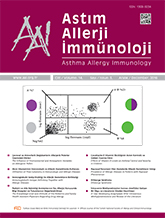


Objective: The prevalence rates of asthma and vitamin D deficiency have been increasing in parallel, leading to significant morbidity. This study aimed to compare the vitamin D levels in the children with asthma and in healthy controls and to assess the relationship between vitamin D levels and asthma clinical parameters and control.
Materials and Methods: 115 children with asthma and 115 controls who presented to the Pediatric Immunology and Allergy outpatient clinic between December 2014 and February 2015 were enrolled in the study. Vitamin D levels were measured. Levels ≥ 20 ng/ml were considered adequate and those lower than 20 ng/ml as deficient. Asthma control was classified according to the Global Initiative for Asthma guidelines (GINA) and Childhood asthma control test (C-ACT).
Results: Serum vitamin D levels were 17.27 (5.77) ng/ml in the asthma group and 22.78 (10.64) ng/ml in the control group, indicating statistical significance (p= 0.001). When the asthma patients were divided into groups according to vitamin D level, 72.2% were deficient while 27.8% had adequate levels. The number of asthma exacerbations, number of emergency service visits and the number of hospitalizations within the last year were higher in the deficient group, compared to the adequate group (p <0.001, p <0.001 and p <0.002, respectively). Uncontrolled asthma rates were higher in the deficient group, compared to the adequate group (p <0.01). Serum vitamin D levels were correlated with the ACT score (r=0.204, p=0.03).
Conclusion: The rate of vitamin D deficiency was higher in asthmatic children compared to the controls. We also showed that increased asthma severity and reduced asthma control were associated with vitamin D deficiency. There was a positive correlation between serum vitamin D levels and asthma control.